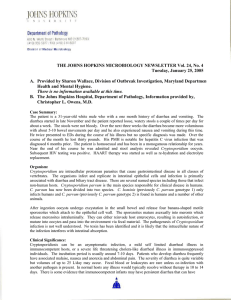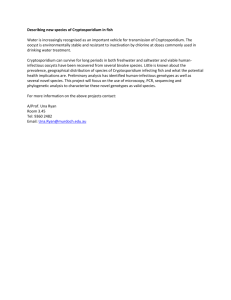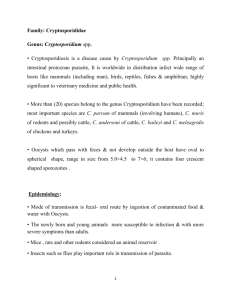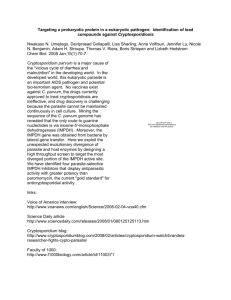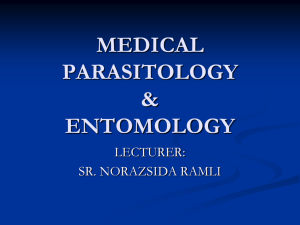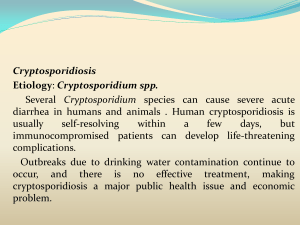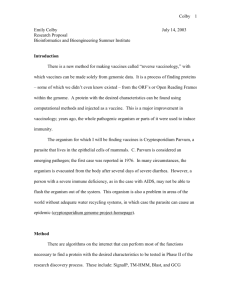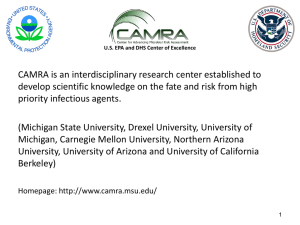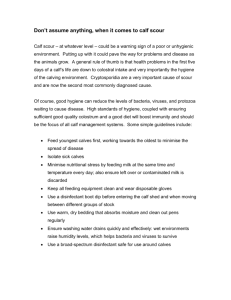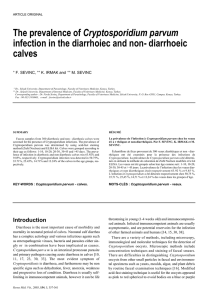cryptosporidiumclass
advertisement
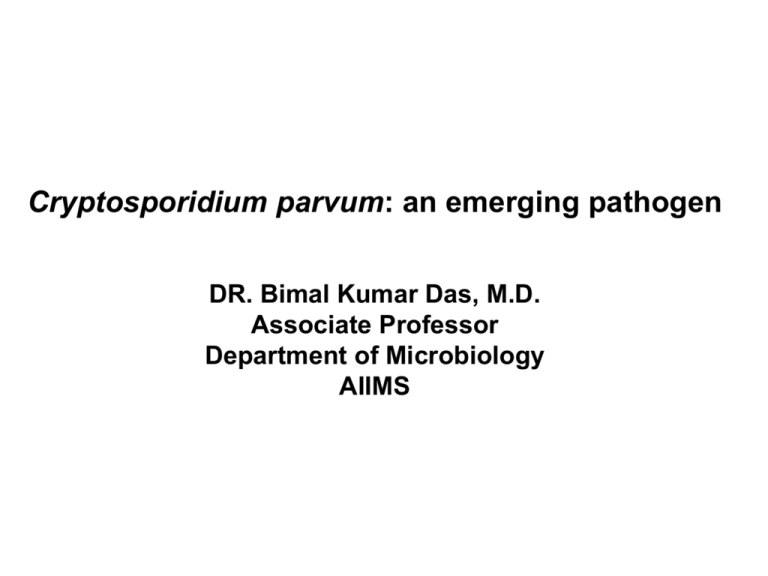
Cryptosporidium parvum: an emerging pathogen DR. Bimal Kumar Das, M.D. Associate Professor Department of Microbiology AIIMS Cryptosporidium parvum: an emerging pathogen •Cryptosporidium is a coccidian protozoan parasite( Sporozoa) • Associated with diarrea in 1976 in a 3-year-old girl in EM of tthe intestinal epithelium • Increasing population of immunocompromised persons and waterborne outbreaks of cryptosporidiosis •Little is known about the pathogenesis of the parasite •Cryptosporidium can infect several different hosts, can survive most environments for long periods Currently identified species Cryptosporidium species Origin of isolate C. parvum Human, Bovine C. wrairi Guinea pigs C. muris Bovine, Murine C. meleagridis Domestic Turkeys C. baileyi Chickens C. serpentis Snakes Life Cycle •Complex monoxenous life cycle--completing its entire cycle within a single host with both sexual and asexual cycles, and there are six distinct developmental stages •Excystation of the orally ingested oocyst in the small bowel with release of the four sporozoites •Invasion of intestinal epithelial cells initiation of the asexual intracellular multiplication stage •Differentiation of microgametes and macrogametes •Fertilization initiating sexual replication & Development of oocysts •The formation of new, infectious sporozoites within the oocyst, which is then excreted in the stool Source:http://biology.kenyon.edu Source: www.cdc.gov Clinical manifestations In immunocompetent patients Cryptosporidiosis is an acute, yet self-limiting diarrheal illness (1-2 week duration), and symptoms include (Juranek, 1995): Frequent, watery diarrhea Nausea Vomiting Abdominal cramps Low-grade fever For immunocompromised persons Illness is much more severe (Juranek, 1995): Debilitating, cholera-like diarrhea (up to 20 liters/day) Severe abdominal cramps Malaise Low-grade fever Weight loss Anorexia C. parvum infection has also been identified in the biliary tract (causing thickening of the gallbladder wall) and the respiratory system. Epidemiology Infection by C. parvum has been reported in six continents In patients aged 3 days to 95 years old Transmission is usually fecal-oral, often through water contaminated by livestock mammal feces Person to person transmission through feco-oral route Cattle farmers, Veterinarians who come in contact with farm animals Infants and younger children in day-care centers 50% infective dose (ID50) of C. parvum is only 132 oocysts ( Resistant to chlorine treatment) Source:http://biology.kenyon.edu Phase contrast photograph of sporozoite release from the Cryptosporidium oocyst Pathogenesis Upon oocyst excystation, four sporozoites are released which adhere their apical ends to the surface of the intestinal mucosa A sporozoite-specific lectin adherence factor has been identified Following attachment cytokines are released from Epithelial cells which activates macrophages Activated macrophages release histamine, serotonin, adenosine, prostaglandins, leukotrienes, and plateletactivating factor which induce loss of fluid and electrolytes Epithelial cells are damaged 1. Cell death is a direct result of parasite invasion, multiplication, and extrusion or 2. Cell damage could occur through T cell-mediated inflammation, producing villus atrophy and crypt hyperplasia Either model produces distortion of villus architecture results in nutrient malabsorption and diarrhea Detection and Diagnosis Staining methods were then developed to detect and identify the oocysts directly from stool samples. The modified acid-fast stain is traditionally used to most reliably and specifically detect the presence of cryptosporidial oocysts ELISA or IFA, has recently been described in diagnosis of cryptosporidiosis PCR (Polymerase Chain Reaction) has been used for C. parvum Source: http://medlib.med.utah.edu C. parvum - Cysts in stool Acid fast A scanning electron micrograph of a broken meront of Cryptosporidium showing the merozoites within. (From: Gardiner et al., 1988,An Atlas of Protozoan Parasites in Animal Tissues, USDA Agriculture Handbook No.651) A scanning electron micrograph of Cryptosporidium lining the intestinal tract. (From: Gardiner et al., 1988,An Atlas of Protozoan Parasites in Animal Tissues, USDA Agriculture Handbook No.651) Duodenal biopsy sample from a patient with AIDS and cryptosporidiosis. Source:http://biology.kenyon.edu Source: http://www.dpd.cdc.gov Cryptosporidium parvum :Oocysts of Cryptosporidium parvum, in wet mount. The oocysts are rounded, 4.2 µm - 5.4 µm in diameter. Sporozoites are visible inside the oocysts Cryptosporidium oocysts ( Original image from a Japanese language site Tentatively titled Internet Atlas of Human Parasitology) Source: http://www.dpd.cdc.gov Oocysts of Cryptosporidium parvum stained by the modified acid-fast method. Against a blue-green background, the oocysts stand out in a bright red stain. Sporozoites are visible inside the two oocysts to the right. “ghosts” Source: http://www.dpd.cdc.gov modified acid-fast method non acid-fast oocysts “ghosts” Source: http://www.dpd.cdc.gov Oocysts of Cryptosporidium parvum stained with the fluorescent stain auramine-rhodamine Giardia cyst C. parvum Source: http://www.dpd.cdc.gov Oocysts of C. parvum (upper left) and cysts of Giardia intestinalis (lower right) labeled with immunofluorescent antibodies Treatment No safe and effective therapy for cryptosporidial enteritis has been successfully developed. Since cryptosporidiosis is a self-limiting illness in immunocompetent individuals, general, supportive care is the only treatment for the illness. Oral or intravenous rehydration and replacement of electrolytes may be necessary Treatment Possibilities: Encouraging results following use of paromomycin (an aminoglycoside antibiotic) have been reported. There is also preliminary evidence to suggest that paromomycin when used at 4 doses of 1.5 -2.0g/day has led to symptom improvement, and even eradication of the parasite. Although Azithromycin and Lactobin-R (bovine colostrum immunoglobulin concentrate) have had some experimental success, no therapeutic agent has been clearly identified as effective (Martins & Guerrant, 1994).
